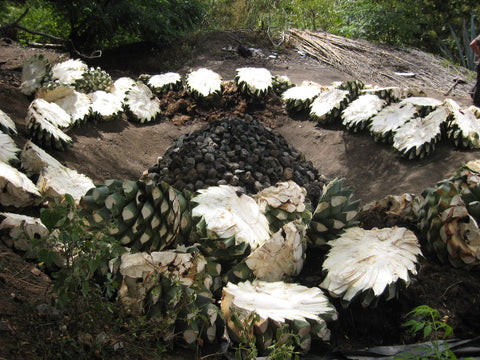Education
What Is Mezcal and How Is It Made?
Mezcal is Mexico’s original agave spirit. The word comes from the Náhuatl mexcalli, meaning cooked agave. Across Mexico, communities have been roasting agave hearts, fermenting the sweet fibers, and distilling in small batches for centuries. Today, mezcal remains a craft defined by place, agave species, and traditional methods—especially in regions like Oaxaca.
What makes mezcal unique?
Origin protected: Mezcal has a Designation of Origin. It can only be produced in authorized regions of Mexico such as Oaxaca, Guerrero, Durango, Puebla, and San Luis Potosí.
Many agaves, many flavors: Unlike tequila (mostly one species, Blue Weber), mezcal can be made from dozens of agave species—each with its own character.
Traditional methods: Earthen-pit roasting, hand or stone milling, wild fermentation, and small-batch distillation (often in clay or copper) create remarkable diversity in the glass.

Lalocura - Tobasiche
Agave (Maguey): The plant behind the spirit
Agave is native to the Americas. The name comes from the Greek agavos, meaning noble. In Mexico, it’s commonly called maguey and known by many Indigenous names: mecelt (Náhuatl), uada (Otomí), doba (Zapotec), among others.
Biodiversity: Mexico is home to 160+ agave species; not all are used for mezcal, but many are. Each species grows at its own pace and expresses its terroir differently.
Time and patience: Maturity varies widely. Espadín may take 7–12 years; Tobalá 12–15+ years; Arroqueño 20–25+ years. Harvesting at full maturity is essential for depth of flavor and sustainability.

From field to copita: The ancestral process
Harvesting and Cutting
When an agave reaches maturity, the maestro mezcalero decides the right moment to harvest. Leaves are cut away and the heart (piña) is taken to the palenque. During trimming, only the best, clean core is kept, this influences sweetness, texture, and final aroma.


Cooking in an earthen pit
To start the cooking process, an earthen pit oven must be prepared, burning wood is tossed into the earthen oven, and it is covered by a bed of river rocks to allow a slow roasting process.
Once the rocks are completely hot, the oven is filled with the harvested piñas and a layer of wet bagazo (leftover fiber from previous fermentations) is added on top of the rocks this helps to protect the piñas from burning.
The oven is covered with a tarpaulin (lona) with a hole in the middle and is sealed with sand and rocks on the edges to prevent being blown by the wind.
The cooking process takes up to 5 days depending on weather conditions.

Earthen pit oven

After the cooking process is completed, the oven is open and the agaves are moved to a resting area to cool down, the maestro mezcalero will decide when the milling process should start.

Cooked Agaves in the resting area
Milling
The cooked agaves are cut into little pieces and during this process, impurities are removed, only the best parts are used during the milling process, as this will ensure the great taste of the Mezcal.
The milling is done with wooden mallets that can weight up to 25 kilos.

25 kg wooden mallets.

Cutting agave into little pieces

Milling Agave
The process can take up to 24 hours of nonstop milling to obtain the fibers from the pieces of piñas that will be used for the next step, the fermentation process.
Other types of milling can be used to accelerate the milling process; however, the use of machines can change the taste of the Mezcal (this is still in dispute among different producers)
Fermentation
The fiber obtained from the milling is put into fermentation tanks made of Sabino wood and spring water is added to start a natural fermentation.
The fermentation process takes between 9 days up to 25 days depending on the size of the tanks, temperature, and the types of agaves used.

Fiber obtained from milling agave

Fiber after the fermentation process begins

Advance fermentation process
Once the fermentation is completed, two products are obtained; tepache (the juice obtained from the fiber) and bagazo (fiber once all the juice is drained from the solid part).
Distillation
The distillation is done with stills made of clay that consist of two clay pots; the first one is filled with tepache and bagazo (depending on the type of agave used in the fermentation).
A hollow clay pot is put on top of the first clay pot and a copper pot is placed in the upper opening, the copper pot is filled with spring water to help with the condensation process inside the clay pots.
The process consists of evaporating all the tepache inside the clay pot, when all the stems reach the top of the copper pot with spring water starts the condensation process. The liquid obtains from the condensation process falls into a wooden spoon that guides it outside of the clay pots into a container.
The product obtained from the second distillation is called ‘puntas, cuerpo y colas’ which are separate in different containers.
Puntas (heads) are the first part of the second distillation with the highest level of alcohol and are rich in aromas.
Cuerpo (body) is the longest part of the distillation from which the Mezcal is mainly made.
Colas (tails) is the last part of the distillation with the lowest level of alcohol.

Clay pot distillation



